
Starfish or sea stars are star-shaped echinoderms belonging to the class Asteroidea. Common usage frequently finds these names being also applied to ophiuroids, which are correctly referred to as brittle stars or basket stars. Starfish are also known as asteroids due to being in the class Asteroidea. About 1,900 species of starfish live on the seabed in all the world's oceans, from warm, tropical zones to frigid, polar regions. They are found from the intertidal zone down to abyssal depths, at 6,000 m (20,000 ft) below the surface.

The Echinasteridae are a family of starfish in the monotypic order Spinulosida. The family includes eight genera and about 133 species found on the seabed in various habitats around the world.
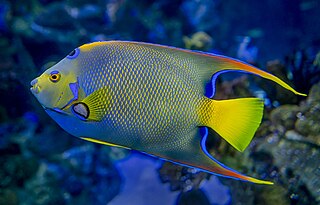
The queen angelfish, also known as the blue angelfish, golden angelfish, or yellow angelfish, is a species of marine angelfish found in the western Atlantic Ocean. It is a benthic warm-water species that lives in coral reefs. It is recognized by its blue and yellow coloration and a distinctive spot or "crown" on its forehead. This crown distinguishes it from the closely related and similar-looking Bermuda blue angelfish, with which it overlaps in range and can interbreed.
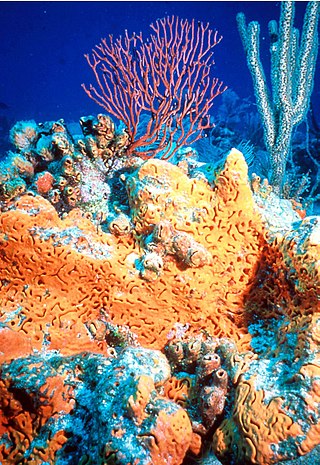
Agelas clathrodes, also known as the orange elephant ear sponge, is a species of sea sponge. It lives on reefs in the Caribbean, usually more than 10 metres (33 ft) below the surface of the ocean. It takes various forms, and its color is reddish orange.

Oreaster reticulatus, commonly known as the red cushion sea star or the West Indian sea star, is a species of marine invertebrate, a starfish in the family Oreasteridae. It is found in shallow water in the western Atlantic Ocean and the Caribbean Sea.

Amphimedon compressa, the erect rope sponge, red tree sponge, red tubular sponge, or red sponge is a demosponge found in southern Florida, the Caribbean Sea, and the Bahamas. It can be deep red, orange, brown, or black.
Sea sponge aquaculture is the process of farming sea sponges under controlled conditions. It has been conducted in the world's oceans for centuries using a number of aquaculture techniques. There are many factors such as light, salinity, pH, dissolved oxygen and the accumulation of waste products that influence the growth rate of sponges. The benefits of sea sponge aquaculture are realised as a result of its ease of establishment, minimum infrastructure requirements and the potential to be used as a source of income for populations living in developing countries. Sea sponges are produced on a commercial scale to be used as bath sponges or to extract biologically active compounds which are found in certain sponge species. Techniques such as the rope and mesh bag method are used to culture sponges independently or within an integrated multi-trophic aquaculture system setting. One of the only true sustainable sea sponges cultivated in the world occur in the region of Micronesia, with a number of growing and production methods used to ensure and maintain the continued sustainability of these farmed species.
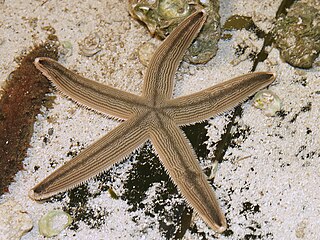
Luidia clathrata is a tropical species of starfish in the family Luidiidae. It is variously known as the slender-armed starfish, the gray sea star, or the lined sea star. It is found in the western Atlantic Ocean.
Aspidodiadema jacobyi is a small sea urchin in the family Aspidodiadematidae. It lives in tropical seas at great depths. Aspidodiadema jacobyi was first scientifically described in 1880 by Alexander Emanuel Agassiz, an American scientist.

Luidia senegalensis, the nine-armed sea star, is a tropical species of starfish in the family Luidiidae found in the western Atlantic Ocean.

Davidaster rubiginosus, the orange sea lily, is a species of crinoid in the family Comatulidae. At one time it was classified as Nemaster rubiginosa but the World Register of Marine Species has determined that the valid name is Davidaster rubiginosus. It is found on reefs in the tropical western Atlantic and the Caribbean Sea.

Pteraster tesselatus, the slime star or cushion star, is a species of starfish in the family Pterasteridae found in the North Pacific.
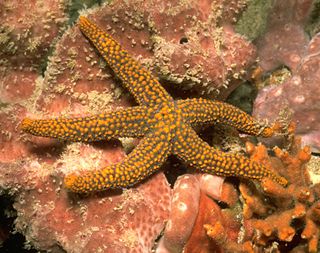
Echinaster spinulosus, the small spine sea star, is a species of sea star found in shallow parts of the western Atlantic Ocean, the Caribbean Sea and Gulf of Mexico.

Pteraster militaris, the wrinkled star, is a species of starfish in the family Pterasteridae. It is found in the northern Pacific Ocean, the Arctic Ocean, the Barents Sea, and the northern Atlantic Ocean.

Astropecten duplicatus, the two-spined sea star, is a starfish in the family Astropectinidae. It is found in the eastern Atlantic Ocean, the Caribbean Sea and the Gulf of Mexico.

Marthasterias is a genus of starfish in the family Asteriidae. Both species in the genus are commonly known as the spiny starfish.
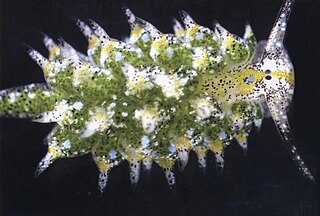
Costasiella ocellifera is a small (5–13 mm) species of sea slug, a shell-less marine gastropod mollusk in the family Costasiellidae. Costasiella ocellifera, and other members of the Costasiellidae family are often mistakenly classified as nudibranchs because they superficially resemble other species of that group, but they are actually a part of the Sacoglossa superorder of sea slugs, also known as the “sap-sucking sea slugs,” "crawling leaves" or the "solar-powered sea slugs." C. ocellifera was discovered by Simroth in 1895, and was initially classified as Doto ocellifera. The Brazilian species, Costasiella liliana, is a synonym of C. ocellifera.Costasiella ocellifera shows long-term retention of functional kleptoplasty.

Echinaster luzonicus, the Luzon sea star, is a species of starfish in the family Echinasteridae, found in shallow parts of the western Indo-Pacific region. It sometimes lives symbiotically with a copepod or a comb jelly, and is prone to shed its arms, which then regenerate into new individuals.

Echinaster is a well-studied and common genus of starfish containing ~30 species and is the second-largest genus found within the family Echinasteridae. The genera Henricia and Echinaster encompass 90% of all the species found within the family Echinasteridae. It contains 30 species, however the number of species in this genus is still debatable because of uncertainty within the genera. This genus is currently sub-divided into two sub-genera: Echinaster and Othilia, evolutionary relationships between the sub-genera is not understood. Echinaster are found in the Pacific, Atlantic and Indian oceans, with most species being studied in the Gulf of Mexico and Brazil. The sub-genera Othilia is thought to encompass species mainly found in the Gulf of Mexico and Brazil. Echinaster is often one of the most studied species within the family Echinasteridae and is often used to find evolutionary relationships.
Dysidea etheria, commonly known as the ethereal sponge or heavenly sponge, is a species of lobate sponge within the class Demospongiae. This marine sponge is known for its light blue color and can be found in the Caribbean as well as off the coasts of Florida and Georgia. Like all other poriferans, D. etheria is capable of both sexual and asexual reproduction. The use of spicule collection as well as chemical defenses allows D. etheria to protect itself against predators such as the zebra doris and the orange knobby star. D. etheria is also known as a host species of the invasive brittle star Ophiothela mirabilis. Lastly, various molecular biology studies have utilized D. etheria to both study foreign particle transport in sponges and to isolate novel molecules.
















